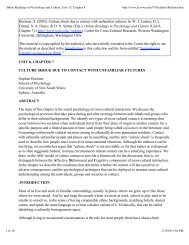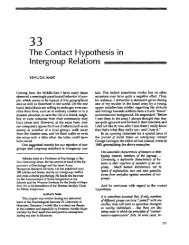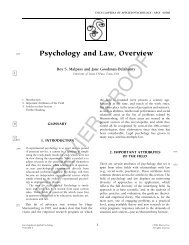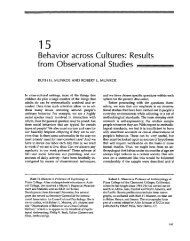The Longest War: Gender and Culture
The Longest War: Gender and Culture
The Longest War: Gender and Culture
You also want an ePaper? Increase the reach of your titles
YUMPU automatically turns print PDFs into web optimized ePapers that Google loves.
17/ <strong>The</strong> <strong>Longest</strong> <strong>War</strong>: <strong>Gender</strong> <strong>and</strong> <strong>Culture</strong> 125<br />
from interlopers. We need to know the kind of work<br />
that people do, <strong>and</strong> how they structure that work.<br />
And we need to know whether there is environmental<br />
pressure on a group to produce more children,<br />
or to have fewer of them. In short, we need to<br />
know about production <strong>and</strong> reproduction.<br />
For example, David Gilmore found that rigid<br />
concepts of manhood tend to exist wherever there<br />
is a great deal of competition for resources-which<br />
is to say, in most places. For the human species, life<br />
has usually been harsh. Consider a tribe trying to<br />
survive in the wilds of a South American forest; or<br />
in the dry <strong>and</strong> unforgiving l<strong>and</strong>scape of the desert;<br />
or in an icy Arctic terrain that imposes limits on the<br />
number of people who can survive by fishing.<br />
When conditions like these exist, men are the sex<br />
that is taught to hunt for large game, compete with<br />
each other for work, <strong>and</strong> fight off enemies. (As<br />
we've noted, this division of labor may originally<br />
have occurred because of men's relatively greater<br />
upper-body muscular strength <strong>and</strong> the fact that<br />
they do not become pregnant or nurse children.)<br />
Men will be socialized to resist the impulse to avoid<br />
confrontation <strong>and</strong> retreat from danger. <strong>The</strong>y will be<br />
"toughened up" <strong>and</strong> pushed to take risks, even<br />
with their lives.<br />
How do you get men to do all this To persuade<br />
men to wage war <strong>and</strong> risk death, argues anthropologist<br />
Marvin Harris (1974), societies have to give<br />
them something-<strong>and</strong> the something is prestige,<br />
power, <strong>and</strong> women. That in turn means you have to<br />
raise obedient women; if the King is going to offer<br />
his daughter in marriage to the bravest warrior, she<br />
has to go when given. In contrast, David Gilmore<br />
finds, in cultures such as Tahiti, where resources are<br />
abundant <strong>and</strong> there are no serious hazards or enemies<br />
to worry about, men don't feel they have to<br />
prove themselves or set themselves apart from<br />
women.<br />
<strong>The</strong> economic realities of life also affect how<br />
men <strong>and</strong> women regard each other. Ernestine Fried1<br />
has described the remarkable differences between<br />
two tribes in New Guinea. One tribe, living in the<br />
highl<strong>and</strong>s, believes that intercourse weakens men,<br />
that women are dangerous <strong>and</strong> unclean, <strong>and</strong> that<br />
menstrual blood can do all sorts of terrifying things.<br />
Sex is considered powerful <strong>and</strong> mysterious; if it is<br />
performed in a garden, the act will blight the crops.<br />
Antagonism between the sexes runs high; men<br />
often delay marriage <strong>and</strong> many remain single. Not<br />
far away, another tribe has an opposite view of<br />
women <strong>and</strong> sex. People in this tribe think sexual<br />
intercourse is fun <strong>and</strong> that it revitalizes men. Sex,<br />
they say, should take place in gardens, as it will<br />
foster the growth of plants. Men <strong>and</strong> women do not<br />
live in segregated quarters, as they do in the highl<strong>and</strong>s,<br />
<strong>and</strong> they get along pretty well.<br />
One possible explanation for these differences<br />
is that the highl<strong>and</strong> people have been settled a long<br />
time <strong>and</strong> have little new l<strong>and</strong> or resources. If the<br />
population increased, food would become scarce.<br />
Sexual antagonism <strong>and</strong> a fear of sexual intercourse<br />
help keep the birth rate low. <strong>The</strong> sexy tribe, however,<br />
lives in uncultivated areas <strong>and</strong> needs more<br />
members to work the l<strong>and</strong> <strong>and</strong> help defend the<br />
group. Encouraging positive attitudes toward sex<br />
<strong>and</strong> early marriage is one way to increase the birth<br />
rate.<br />
Cross-cultural studies find that when the sexes<br />
are mutually dependent <strong>and</strong> work cooperatively, as<br />
in husb<strong>and</strong>-wife teams, sexual antagonism is much<br />
lower than when work is organized along sex-segregated<br />
lines. Among the Machiguenga Indians of<br />
Peru, where the sexes cooperate in growing vegetables,<br />
fishing, <strong>and</strong> recreation, husb<strong>and</strong>s <strong>and</strong> wives<br />
feel more solidarity with each other than with their<br />
same-sex friends. Among the Mundurucu, however,<br />
women <strong>and</strong> men work in same-sex groups,<br />
<strong>and</strong> friendships rarely cross sexual lines; women<br />
therefore feel a sense of solidarity with other<br />
women, men with men.<br />
In our own culture, changing conditions have<br />
profoundly influenced our ideas about gender as<br />
well as our family relationships. According to<br />
Francesca Cancian (1987), before the nineteenth<br />
century, the typical household was a cooperative<br />
rural community in which both spouses shared responsibility<br />
for the material <strong>and</strong> emotional well-being<br />
of the family. Men didn't "go to work"; work<br />
was right there, <strong>and</strong> so was the family. Women<br />
raised both chickens <strong>and</strong> children. This is not to say<br />
that the two sexes had equal rights in the public<br />
domain, but in psychological terms they were not<br />
seen as opposites.<br />
But with the onset of the industrial revolution,<br />
shops <strong>and</strong> factories began to replace farming, <strong>and</strong><br />
many men began to work apart from their families.<br />
This major economic change, argues Cancian, created<br />
a rift between "women's sphere," at home, <strong>and</strong><br />
"men's sphere," at work. <strong>The</strong> masculine ideal adjusted<br />
to fit the new economic realities, which now<br />
required male competitiveness <strong>and</strong> the suppression<br />
of any signs of emotional "weakness." <strong>The</strong> feminine<br />
ideal became its opposite: Women were now<br />
seen as being "naturally" nurturant, emotional, <strong>and</strong><br />
fragile.







